Article by Dr Sarah John, Research Director at FairVote
In the aftermath of the Nevada caucuses, Donald Trump seems almost inevitable as the Republican presidential nominee. Yet, Trump is yet to win a majority of the vote in any of the four contests held so far (24.3% in Iowa, 35.3% in New Hampshire, 32.5% in South Carolina and 45.9% in Nevada). And, in many ways, the perception of Trump’s inevitability has its roots in the voting system. Caucus and primary voters are asked to express a single preference (see the image below, showing a Nevada caucus ballot), and, in a divided multi-candidate field, we can only tell which candidate has the most intense support, not which candidate has the broadest or most support overall.
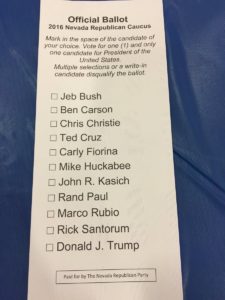
But, what if Republican primary and caucus voters used preferential voting, like we do for most elections in Australia—ranking candidates so it is possible to figure out who is truly the most popular candidate?
A national poll, commissioned by FairVote, a non-partisan organization that advocates for preferential voting in American elections, asked 1,000 Republican and independent likely voters to rank the Republican presidential candidates (ie. FairVote asked them to vote like Australians). The respondents were surveyed between January 21st and February 8th, which was around the time of the Iowa caucuses when 11 candidates were still in the race.
The results of this poll show that Trump is not necessarily the most preferred Republican candidate.

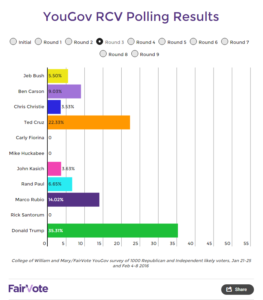
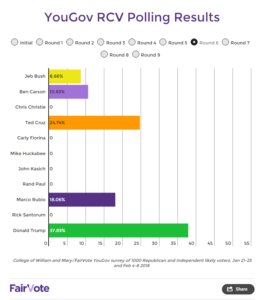
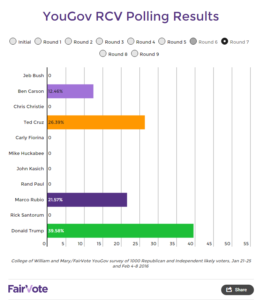
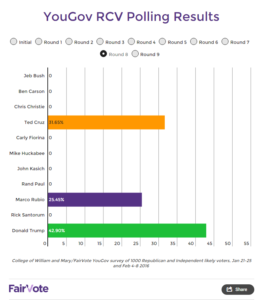

Closely reflecting most national polls before the Nevada caucuses, Donald Trump won 35% of the primary vote. By contrast, Ted Cruz received 22% of the primary vote, and Marco Rubio, 13%. As the preferential voting count continues, however, Cruz gains on Trump and, in the last round when Rubio is eliminated, Cruz emerges as the most popular candidate with 51% of the vote. Although this is within the margin of error of the survey, it does demonstrate how close the race is and the extent to which Trump is not the frontrunner he appears to be in a first-past-the-post system.
Similarly, in a contest between Trump and Rubio, who emerged stronger out of the tenth Republican presidential debate on Thursday, Trump wins 54% to 46%. This is a much closer contest that oftentimes reported.
And, from respondents’ preference orders, we can see just how polarizing a candidate Trump is. Of respondents who ranked candidates, fully 21% put him dead last out of the 11 candidates. Only 5% ranked Cruz last, and only 2% ranked Rubio last—the lowest for any candidate. Indeed, fewer respondents ranked Cruz (17%) and Rubio (18%) as one of the four least preferred candidates than ranked Trump (21%) as their least preferred candidate. Almost one in three (31%) of respondents listed Trump as one of their four least preferred candidates. Additionally, more people ranked Cruz in their top four than Trump. A full 63% of respondents ranked Cruz in their top four candidates, compared to 58% for Trump and 54% for Rubio.
The clear conclusion is that electoral systems matter. If the Republican Party used preferential voting, Trump might not seem inevitable, and the bandwagon effect, in which more and more people decide to back the likely winner, might not be assisting Trump the way it is at the moment. Instead, we’d be hearing much more about the neck-and-neck contest between Trump, Cruz and Rubio.
Disclaimer: this is the view of the author and Flinders University does not take responsibility for the accuracy or completeness of the material and does not accept responsibility for, or endorse the contact or condition of, any linked website.

